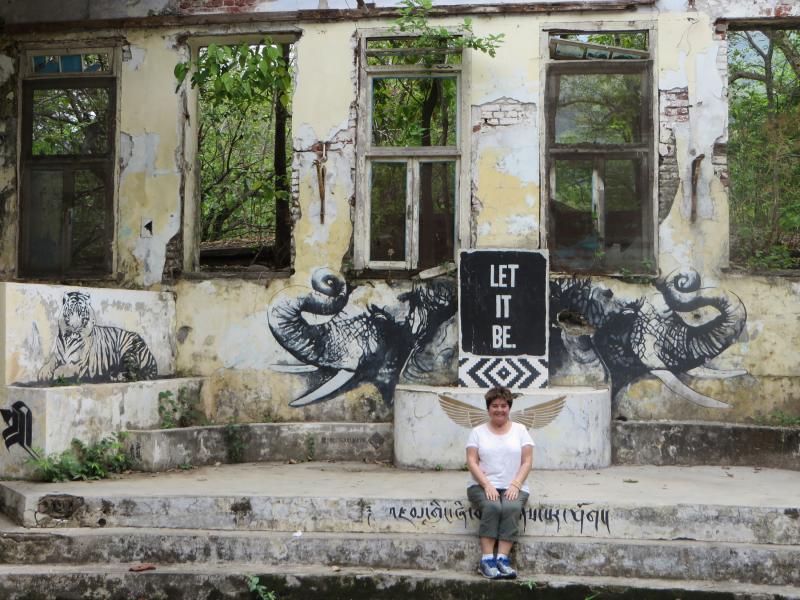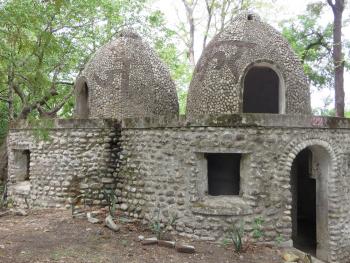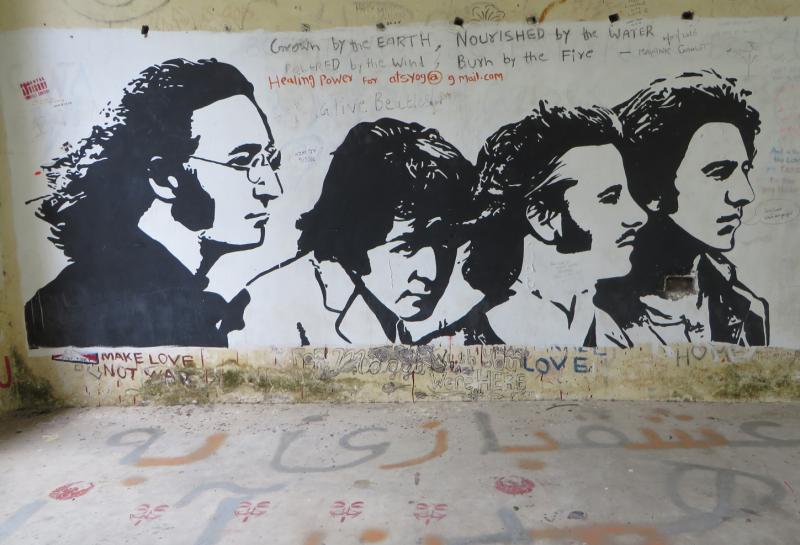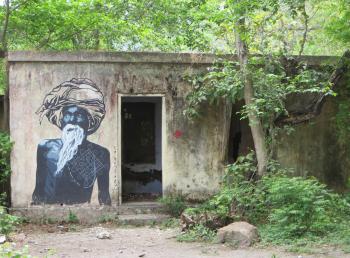Traveling ‘Across the Universe’ to find remembrances of the Beatles in India
This article appears on page 22 of the November 2017 issue.
Rishikesh, India, may not sound familiar to many people, but if I say it is home to “The Beatles’ Ashram,” those of us of a certain age know the place I am talking about.
The town of Rishikesh has become a center for studying yoga and meditation, with lots of ashrams (religious retreats) — some of which cost only $3 per day, including meals and classes — small hotels and a few more upscale properties. It is located in the Himalayan foothills in the state of Uttarakhand, a 45-minute flight or 4-hour train or car ride from Delhi.
Most tourists who visit are Indian nationals who are on pilgrimages visiting a circuit of Hindu sites, including the Ganges for a dip in this sacred river.
There are many sadhus around with long hair, beards, dusty orange robes and symbols painted on their bodies. These ascetics give up all worldly goods, and most live in ashrams, while some take over the care of small temples (there are many around) or even live inside caves in the surrounding foothills.
Know that the holy city of Rishikesh is “dry” as well as vegetarian, so no liquor is allowed nor meat, eggs or fish; however, milk products like yogurt and cheeses are available.
The ashram
February 2018 will mark the 50th anniversary of the Beatles’ arrival in Rishikesh to study Transcendental Meditation with the charismatic Maharishi Mahesh Yogi. As it turned out, the best thing to come out of their stay, which was not without its problems, was a collection of 48 songs, many of which appeared on their “White Album,” released later that year, and on their “Abbey Road” album, released in 1969.
In the early 1960s, the Maharishi leased 20 acres of land at the edge of town from the forest department in order to build his Transcendental Meditation center. The finished site contained pleasant walking paths, water features, small shrines, attractive landscaping and private meditation “caves” (actually, small 2-story domed buildings) plus an auditorium and yoga and meditation pavilions.
Accommodations were available in stand-alone bungalows, as well as in a 4-story, hotel-like building. Many of the walkways, buildings and meditation structures were decorated with pebbles sourced from the nearby Ganges River.
The whole property was considered quite luxurious in its day. At its peak, the ashram accommodated 1,500 followers.
After the 20-year lease expired, the Maharishi moved his center to Switzerland, and the ashram in Rishikesh functioned for a few years without a lease before finally being abandoned.
In the mid-1990s, the forest department locked the gates, declared it off-limits and “let it be” for the next couple of decades. Slowly, the buildings fell into disrepair, and the forest now known as Rajaji National Park closed in.
In 2015, the forest department decided to clean up the property a bit and rename it The Beatles Ashram. In December of that year, the area was opened to the public.
The buildings are derelict, some ready to fall down. Most have been stripped of any decorative items and porcelain fixtures.
Over the years, graffiti artists — some good, some mediocre — have decorated much of the property, so even if you are not a fan of The Beatles, it’s worth a visit for the artwork. Thank goodness an organization of well-respected artists trespassed onto the site in 2012 and garnished many buildings with high-quality murals. (You can see their work at www.instagram.
com/beatlesashramofficial.)
My visit
When I learned that the ashram was open to visitors, I made arrangements to spend a week in Rishikesh at my favorite hotel, Ganga Kinare – a Riverside Boutique Hotel (237 Virbhadra Rd.; phone +91 901 5544000, www.gangakinare.com).
I booked a Beatles Ashram tour through the hotel, and they provided a guide and car for the trip, including two hours of waiting time for the driver while I visited the site. The cost of the tour was 2,700 Indian rupees ($42), with the understanding that I would pay a separate entrance fee on site.
As luck would have it, Raj Singh (tourguideraj@gmail.com) was assigned as my guide. Raj had guided a friend and me on a previous visit to Rishikesh (January 2016). He is an excellent guide and was so well prepared that he brought along insect repellent, water, candy and a hat for me to use.
He is a native of Rishikesh as well as an independent, licensed guide. This is a good combination.
The site is open from 9 a.m. to 5 p.m. daily, and it’s about a half-hour drive from town, across a bridge and then along a long and winding road. The admission fee is higher for foreigners (600 rupees, $9) than for Indian nationals (150 rupees); one would hope that the extra “foreigner fee” helps with upkeep and restoration.
As I walked around, I used my imagination and could almost see The Beatles standing there. Their personal meditation cave was signposted but not the rooms where they stayed.
The area was quiet, with just birds chirping and insects buzzing.
Maybe it was a pilgrimage and maybe it was just a look at a bit of 1960s history, but I wanted to take in every little thing.
Hotel highlights
The combination of spending time at The Beatles Ashram and staying at the 4-star Ganga Kinare Hotel was a stellar duo.
This was my third visit to this hotel, and I cannot imagine a property with a friendlier, yet professional, staff. The general manager, Sitanshu Kaul, is visible throughout the day and enjoys talking with guests. We had several nice conversations centering on philosophy and religion.
The hotel has several cost-effective packages, and I selected the 7-day “Body Purification Spa Package” for my June 2017 visit. (Note: October through February is the best time to visit, as those are the cooler months.)
The price of a package depends on the time of year (high season vs. low season) and the category of room selected. I booked one of their two Lotus Suites for the week, and the price, including taxes, was 90,000 Indian rupees ($1,400), including seven spa sessions ranging from 60 to 90 minutes each, two meals a day and all taxes.
It was a very good value, as the rack rate for just the room with breakfast was 18,000 rupees ($280) a day.
Complimentary daily yoga and meditation sessions led by the resident master Akhilesh Kumar Pandey, an evening spiritual walk and morning and evening aarti (fire ceremony) are open to all guests.
A spa package with the same inclusions and accommodation in a Deluxe (standard) Room starts at 55,000 rupees ($854) for the week, but I have learned that if you plan to stay in one place for a while, you should select the best accommodation you can afford, as the room is important.
I have to admit that I enjoyed staying in the suite on the fourth level of the building, with its floor-to-ceiling windows and straight-on views of the hotel gardens as well as the Ganges and, across the river, the national park.
I became especially fond of my huge, wall-mounted flat-screen TV and had a lot of fun going through its 994 channels. It finally hit me that with 22 official languages in India, plus a bunch of others, each language group has its own news stations, soap operas, music stations and sports stations.
The hotel’s spa uses Ayurvedic principles, with a few Western treatments, like Swedish massage, available. Ayurveda is a 5,000-year-old holistic healing-and-wellness system that is considered a medical practice in India.
The herbs and oils used are a mystery to me, but the different massage techniques were wonderful, and I felt relaxed and energized after each spa session.
Even if you’re not interested in the spa program, there are other packages available: adventure, rafting, sightseeing and yoga. They are worth investigating.
I booked 11 months in advance, as this 38-room property is popular and I wanted to be assured of getting the dates I wanted.
I’m glad I spent time at the lovely Ganga Kinare Hotel, and I know that all the ashram site needs is a little love to become a major tourist spot. I wish there truly were “eight days a week” so my delightful visit would have lasted even longer.




